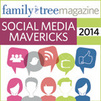|
Here is the 3rd installment in my Genealogists [or Family Historians] and the Tech Tools They Use to Research week-long guest post series. Andrew Martin is the author of History Repeating the Family History Blog. I believe 3 years ago he was one of the first Twitter accounts from the UK I followed and one of the first UK blogs I read. I distinctly remember being quite impressed with his website and research. In his guest post today, Andrew does a wonderful job describing how he technology can be used to have family history find you. So enjoy his guest post and find out how he uses tech to get the job done. ~Caroline  5 Ways To Get Your Family History To Find You Online We lead busy lives, meaning that our time to research can be quite limited. I find it hard to juggle my research around the other things that I do during my free time. I began publishing my family history research online in 1998, and I’ve found that this has vastly helped it by attracting other family historians researching the same or similar branches, who are then able to help correct or fill in parts of my tree. Putting your family history online can open the door of opportunity. Suddenly an international audience can read your work and they can contact you to offer more information, photos, corrections, or even to reunite long-lost branches. This has helped me to smash through those dreaded genealogy brick walls, and unravel mysteries of sudden disappearances due to emigration. So to help you benefit from this more ‘community’ approach to research, I’ve picked out five online tools that I use to help my family history find me: Blogging Blogging is by far the best platform on which to share your own family research. Most blogging tools are free (like Wordpress, Blogspot and Tumblr) and they are also relatively easy to use – without having to download software or subscribe to some complicated and expensive packages. Most blogging tools allow you to blog on the go, so you could even blog from an archive on your smartphone to share a real-time eureka moment, or blog a photo of an amazing headstone during a graveyard search. Blogs work well with search engines like Google and Bing, and the more established your blog gets (the older it is, and the more blog posts you publish), then the more likely search engines will lead people to your research. So by showing off your latest success, or by publishing your latest search conundrum, you stand a good chance that someone will find it, read it, and leave you a comment that could give you that new lead to break through that research brick wall. Think of your blog as the ultimate read – this is where you should regularly put in some hard work. You can write short or long posts, general or really niche posts – it really shouldn’t matter as long as you use the blog’s own ‘tag’ tools to help readers and search engines find your post. The 140-character, ‘micro-blogging’ tool Twitter is always hitting the headlines, and this is because it is easy to use, short in content, and delivered in real time – resulting in some quickly evolving subjects being widely discussed by millions of people around the world at any one time. Initially I was hesitant about how useful Twitter was going to be for genealogy, but I’ve since found it to be an excellent tool for networking with local and international experts across a range of subjects. Twitter’s growing genealogy, history, architecture and archaeology users are a friendly bunch, and in my experience they are more than willing to help others find answers. Other Twitter users have helped me to decipher poor handwriting on death certificates (revealing a cause of death), they’ve helped me date photographs and find records, and they have helped me to find locations that have long since vanished from modern maps. I’ve often discovered local genealogy and history events through twitter, and by using twitter whilst at events like Who Do You Think You Are? In London, I’ve managed to meet up (in real life!) with fellow genealogists – which really puts the ‘social’ into ‘social networking’. With your blog as the ultimate read, your Twitter account is the ultimate net with which to catch your readers and bring them to see your research. This is why a blog is a crucial first step. Forums Forums have been around for many years and these were my first port of call when starting out with my genealogy. RootsChat.com and RootsWeb.com have been incredibly helpful with finding answers to questions. My research has certainly benefited from the kindness of fellow users of both of these who seem ready to freely help where they can. Of course, the more open you are to helping others with their research, then the more likely you will be able to call on a favour at a later date. I have often received look-up help from people who have access to local knowledge or records in other counties and countries outside of the one that I’m researching and living in. Forums are also great environments to bounce your latest family tree research theory and gain opinions from other interested people who have more than likely been there before. Flickr Flickr has been established for many years now, and is the perfect place to upload your photographs. You can even use Flickr as the space where your photos are stored and then feed them through into your blog or website using their embeddable ‘widgets’. I’ve been putting my family photos into collections on Flickr for some time and it always leads to people posting comments in response, and leading to email or offline conversations about the places or families. You can also pin your photos onto maps to help people find them. Like blogs, Flickr is very search engine friendly, so if you remember to add ‘tags’ to your images, then you’ll end up with lots of people looking at them. Recently, some of my photos on Flickr that were taken at early 20th century weddings, were used (with my permission) in an online fashion gallery after being seen by London’s Victoria and Albert Museum. Pinterest, launched in 2011, is a new tool that a genealogist can seize to their advantage. Like Flickr, it’s a great place to find, share, and discuss images. You can ‘pin’ images you like on to your own ‘pin boards’ so that those following you can see them. Alternatively, you can ‘re-pin’ images that you’ve seen – instantly sharing them those who follow you. Pinterest is currently riding the wave of popularity, meaning that a vast number of people are using it right now. It is commonly used to showcase images of baking and other home-crafts, but now is a great time to add your family photos to begin conversations with people and maybe find those long-lost relatives. Essentially, with all five of these tools, the more you put in, then the more you’ll get out. If you can invest some time to regularly put content into one, some, or all of the above, you will find that the number of people coming forward with information will increase. I’ve managed to receive photos and documents, met distant relatives, solved many seemingly impossible puzzles that had baffled me for years. None of this would have been possible without the kindness of the enthusiastic strangers (just like you and I) that use social networking tools. BIO Andrew Martin is a 30-something British genealogist, who has been hooked on researching his family history since 1995, when he was given a scruffy hand-drawn tree of names he didn’t recognize and a few old photos. He owns www.familytreeuk.co.uk website which focuses on his family in Cambridgeshire, England – where his family have lived since at least 1589. He also writes for www.andrewinthegarden.com and www.onehundredwordsmagazine.com.
1 Comment
Seonaid Lewis (genebrarian)
8/17/2014 04:41:32 pm
Google Plus is also excellent. Lots of genealogists and family historians on there. I'm not on as much as I would like . . . but they regularly have Google Hangouts which is terrific for sharing information in real time.
Reply
Leave a Reply. |
Categories
All
Archives
February 2017
|
|
© Copyright For Your Family Story 2016 - All Rights Reserved
|

